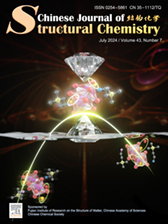
Cover Picture
Pressure-induced emission in 0D metal halide (EATMP)SbBr5 by regulating exciton-phonon coupling
Jiayuan Liang, Xin Mi, Songhao Guo, Hui Luo, Kejun Bu, Tonghuan Fu, Menglin Duan, Yang Wang, Qingyang Hu, Rengen Xiong, Peng Qin*, Fuqiang Huang, Xujie Lü*
Submit a Manuscript
Pressure-induced emission in 0D metal halide (EATMP)SbBr5 by regulating exciton-phonon coupling
Jiayuan Liang, Xin Mi, Songhao Guo, Hui Luo, Kejun Bu, Tonghuan Fu, Menglin Duan, Yang Wang, Qingyang Hu, Rengen Xiong, Peng Qin*, Fuqiang Huang, Xujie Lü*
Submit a Manuscript
Mn-modulated Co–N–C oxygen electrocatalysts for robust and temperature-adaptative zinc-air batteries
Shaojie Ding, Henan Wang, Xiaojing Dai, Yuru Lv, Xinxin Niu, Ruilian Yin, Fangfang Wu, Wenhui Shi, Wenxian Liu*, Xiehong Cao
Chin. J. Struct. Chem., 2024, 43: 100302. DOI: 10.1016/j.cjsc.2024.100302
July 15, 2024
Zinc-air batteries; Oxygen reduction reaction; Electrocatalysis; Nitrogen-doped carbon; Temperature adaptability
ABSTRACT
Flexible zinc-air batteries (FZABs) are featured with safety and high theoretical capacity and become one of the ideal energy supply devices for flexible electronics. However, the lack of cost-effective electrocatalysts remains a major obstacle to their commercialization. Herein, we synthesized a porous dodecahedral nitrogen-doped carbon (NC) material with Co and Mn bimetallic co-embedding (CoxMn1−x@NC) as a highly efficient oxygen reduction reaction (ORR) catalyst for ZABs. The incorporation of Mn effectively modulates the electronic structure of Co sites, which may lead to optimized energetics with oxygen-containing intermediates thereby significantly enhancing catalytic performance. Notably, the optimized Co4Mn1@NC catalyst exhibits superior E1/2 (0.86 V) and jL (limiting current density, 5.96 mA cm−2) compared to Pt/C and other recent reports. Moreover, aqueous ZAB using Co4Mn1@NC as a cathodic catalyst demonstrates a high peak power density of 163.9 mW cm−2 and maintains stable charging and discharging for over 650 h. Furthermore, FZAB based on Co4Mn1@NC can steadily operate within the temperature range of −10 to 40 °C, demonstrating the potential for practical applications in complex climatic conditions.







